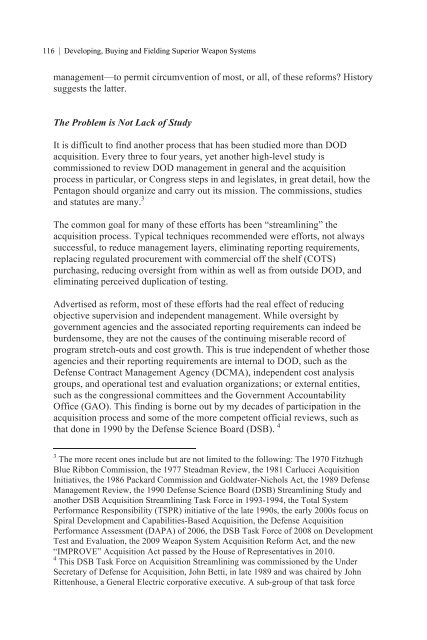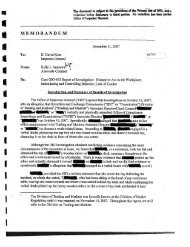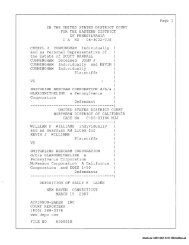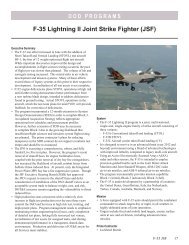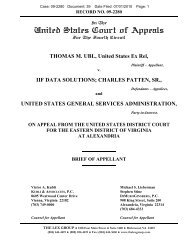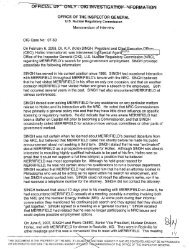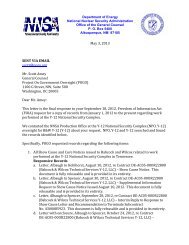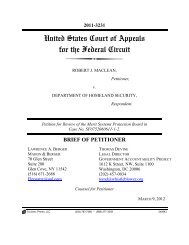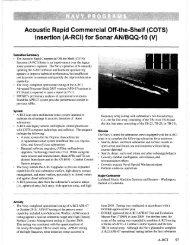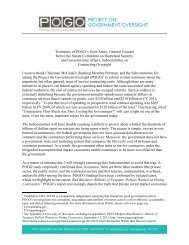The Pentagon Labyrinth
The Pentagon Labyrinth
The Pentagon Labyrinth
Create successful ePaper yourself
Turn your PDF publications into a flip-book with our unique Google optimized e-Paper software.
116 | Developing, Buying and Fielding Superior Weapon Systems<br />
management—to permit circumvention of most, or all, of these reforms? History<br />
suggests the latter.<br />
<strong>The</strong> Problem is Not Lack of Study<br />
It is difficult to find another process that has been studied more than DOD<br />
acquisition. Every three to four years, yet another high-level study is<br />
commissioned to review DOD management in general and the acquisition<br />
process in particular, or Congress steps in and legislates, in great detail, how the<br />
<strong>Pentagon</strong> should organize and carry out its mission. <strong>The</strong> commissions, studies<br />
and statutes are many. 3<br />
<strong>The</strong> common goal for many of these efforts has been “streamlining” the<br />
acquisition process. Typical techniques recommended were efforts, not always<br />
successful, to reduce management layers, eliminating reporting requirements,<br />
replacing regulated procurement with commercial off the shelf (COTS)<br />
purchasing, reducing oversight from within as well as from outside DOD, and<br />
eliminating perceived duplication of testing.<br />
Advertised as reform, most of these efforts had the real effect of reducing<br />
objective supervision and independent management. While oversight by<br />
government agencies and the associated reporting requirements can indeed be<br />
burdensome, they are not the causes of the continuing miserable record of<br />
program stretch-outs and cost growth. This is true independent of whether those<br />
agencies and their reporting requirements are internal to DOD, such as the<br />
Defense Contract Management Agency (DCMA), independent cost analysis<br />
groups, and operational test and evaluation organizations; or external entities,<br />
such as the congressional committees and the Government Accountability<br />
Office (GAO). This finding is borne out by my decades of participation in the<br />
acquisition process and some of the more competent official reviews, such as<br />
that done in 1990 by the Defense Science Board (DSB). 4<br />
3 <strong>The</strong> more recent ones include but are not limited to the following: <strong>The</strong> 1970 Fitzhugh<br />
Blue Ribbon Commission, the 1977 Steadman Review, the 1981 Carlucci Acquisition<br />
Initiatives, the 1986 Packard Commission and Goldwater-Nichols Act, the 1989 Defense<br />
Management Review, the 1990 Defense Science Board (DSB) Streamlining Study and<br />
another DSB Acquisition Streamlining Task Force in 1993-1994, the Total System<br />
Performance Responsibility (TSPR) initiative of the late 1990s, the early 2000s focus on<br />
Spiral Development and Capabilities-Based Acquisition, the Defense Acquisition<br />
Performance Assessment (DAPA) of 2006, the DSB Task Force of 2008 on Development<br />
Test and Evaluation, the 2009 Weapon System Acquisition Reform Act, and the new<br />
“IMPROVE” Acquisition Act passed by the House of Representatives in 2010.<br />
4 This DSB Task Force on Acquisition Streamlining was commissioned by the Under<br />
Secretary of Defense for Acquisition, John Betti, in late 1989 and was chaired by John<br />
Rittenhouse, a General Electric corporative executive. A sub-group of that task force


